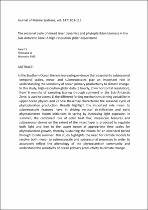 ResearchSpace
ResearchSpace
The seasonal cycle of mixed layer dynamics and phytoplankton biomass in the Sub-Antarctic Zone: A high-resolution glider experiment
JavaScript is disabled for your browser. Some features of this site may not work without it.
- ResearchSpace
- →
- Research Publications/Outputs
- →
- Journal Articles
- →
- View Item
| dc.contributor.author |
Swart, S

|
|
| dc.contributor.author |
Thomalla, Sandy J

|
|
| dc.contributor.author |
Monteiro, Pedro MS

|
|
| dc.date.accessioned | 2018-03-02T10:08:04Z | |
| dc.date.available | 2018-03-02T10:08:04Z | |
| dc.date.issued | 2014-06 | |
| dc.identifier.citation | Swart, S., Thomalla, S.J. and Monteiro, P.M.S. 2014. The seasonal cycle of mixed layer dynamics and phytoplankton biomass in the Sub-Antarctic Zone: A high-resolution glider experiment. Journal of Marine Systems, vol. 147: 103-115 | en_US |
| dc.identifier.issn | 0924-7963 | |
| dc.identifier.uri | http://www.sciencedirect.com/science/article/pii/S0924796314001535 | |
| dc.identifier.uri | DOI: 10.1016/j.jmarsys.2014.06.002 | |
| dc.identifier.uri | http://hdl.handle.net/10204/10067 | |
| dc.description | Copyright: 2014 Springer. Due to copyright restrictions, the attached PDF file only contains the abstract of the full text item. For access to the full text item, please consult the publisher's website. | en_US |
| dc.description.abstract | In the Southern Ocean there is increasing evidence that seasonal to subseasonal temporal scales, meso- and submesoscales play an important role in understanding the sensitivity of ocean primary productivity to climate change. In this study, high-resolution glider data (3 hourly, 2 km horizontal resolution), from~6 months of sampling (spring through summer) in the Sub-Antarctic Zone, is used to assess 1) the different forcing mechanisms driving variability in upper ocean physics and 2) how thesemay characterize the seasonal cycle of phytoplankton production. Results highlight the important role meso- to submesoscale features have in driving vertical stratification and early phytoplankton bloom initiations in spring by increasing light exposure. In summer, the combined role of solar heat flux, mesoscale features and subseasonal storms on the extent of the mixed layer is proposed to regulate both light and iron to the upper ocean at appropriate time scales for phytoplankton growth, thereby sustaining the bloom for an extended period through to late summer. This study highlights the need for climate models to resolve both meso- to submesoscale and subseasonal processes in order to accurately reflect the phenology of the phytoplankton community and understand the sensitivity of ocean primary productivity to climate change. | en_US |
| dc.language.iso | en | en_US |
| dc.publisher | Elsevier | en_US |
| dc.relation.ispartofseries | Worklist;13271 | |
| dc.subject | Sub-Antarctic Zone | en_US |
| dc.subject | Mixed layer depth | en_US |
| dc.subject | Stratification | en_US |
| dc.subject | Primary production | en_US |
| dc.subject | Ocean glider | en_US |
| dc.title | The seasonal cycle of mixed layer dynamics and phytoplankton biomass in the Sub-Antarctic Zone: A high-resolution glider experiment | en_US |
| dc.type | Article | en_US |
| dc.identifier.apacitation | Swart, S., Thomalla, S. J., & Monteiro, P. M. (2014). The seasonal cycle of mixed layer dynamics and phytoplankton biomass in the Sub-Antarctic Zone: A high-resolution glider experiment. http://hdl.handle.net/10204/10067 | en_ZA |
| dc.identifier.chicagocitation | Swart, S, Sandy J Thomalla, and Pedro MS Monteiro "The seasonal cycle of mixed layer dynamics and phytoplankton biomass in the Sub-Antarctic Zone: A high-resolution glider experiment." (2014) http://hdl.handle.net/10204/10067 | en_ZA |
| dc.identifier.vancouvercitation | Swart S, Thomalla SJ, Monteiro PM. The seasonal cycle of mixed layer dynamics and phytoplankton biomass in the Sub-Antarctic Zone: A high-resolution glider experiment. 2014; http://hdl.handle.net/10204/10067. | en_ZA |
| dc.identifier.ris | TY - Article AU - Swart, S AU - Thomalla, Sandy J AU - Monteiro, Pedro MS AB - In the Southern Ocean there is increasing evidence that seasonal to subseasonal temporal scales, meso- and submesoscales play an important role in understanding the sensitivity of ocean primary productivity to climate change. In this study, high-resolution glider data (3 hourly, 2 km horizontal resolution), from~6 months of sampling (spring through summer) in the Sub-Antarctic Zone, is used to assess 1) the different forcing mechanisms driving variability in upper ocean physics and 2) how thesemay characterize the seasonal cycle of phytoplankton production. Results highlight the important role meso- to submesoscale features have in driving vertical stratification and early phytoplankton bloom initiations in spring by increasing light exposure. In summer, the combined role of solar heat flux, mesoscale features and subseasonal storms on the extent of the mixed layer is proposed to regulate both light and iron to the upper ocean at appropriate time scales for phytoplankton growth, thereby sustaining the bloom for an extended period through to late summer. This study highlights the need for climate models to resolve both meso- to submesoscale and subseasonal processes in order to accurately reflect the phenology of the phytoplankton community and understand the sensitivity of ocean primary productivity to climate change. DA - 2014-06 DB - ResearchSpace DP - CSIR KW - Sub-Antarctic Zone KW - Mixed layer depth KW - Stratification KW - Primary production KW - Ocean glider LK - https://researchspace.csir.co.za PY - 2014 SM - 0924-7963 T1 - The seasonal cycle of mixed layer dynamics and phytoplankton biomass in the Sub-Antarctic Zone: A high-resolution glider experiment TI - The seasonal cycle of mixed layer dynamics and phytoplankton biomass in the Sub-Antarctic Zone: A high-resolution glider experiment UR - http://hdl.handle.net/10204/10067 ER - | en_ZA |





